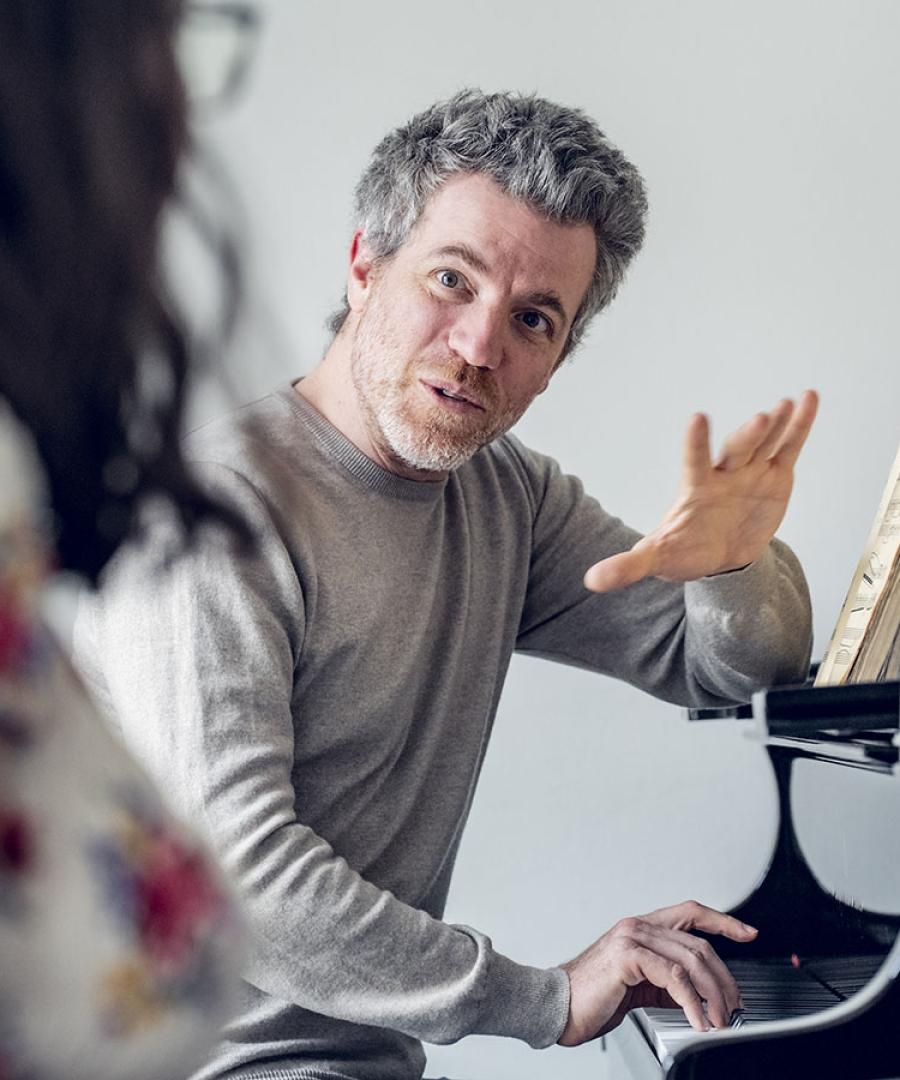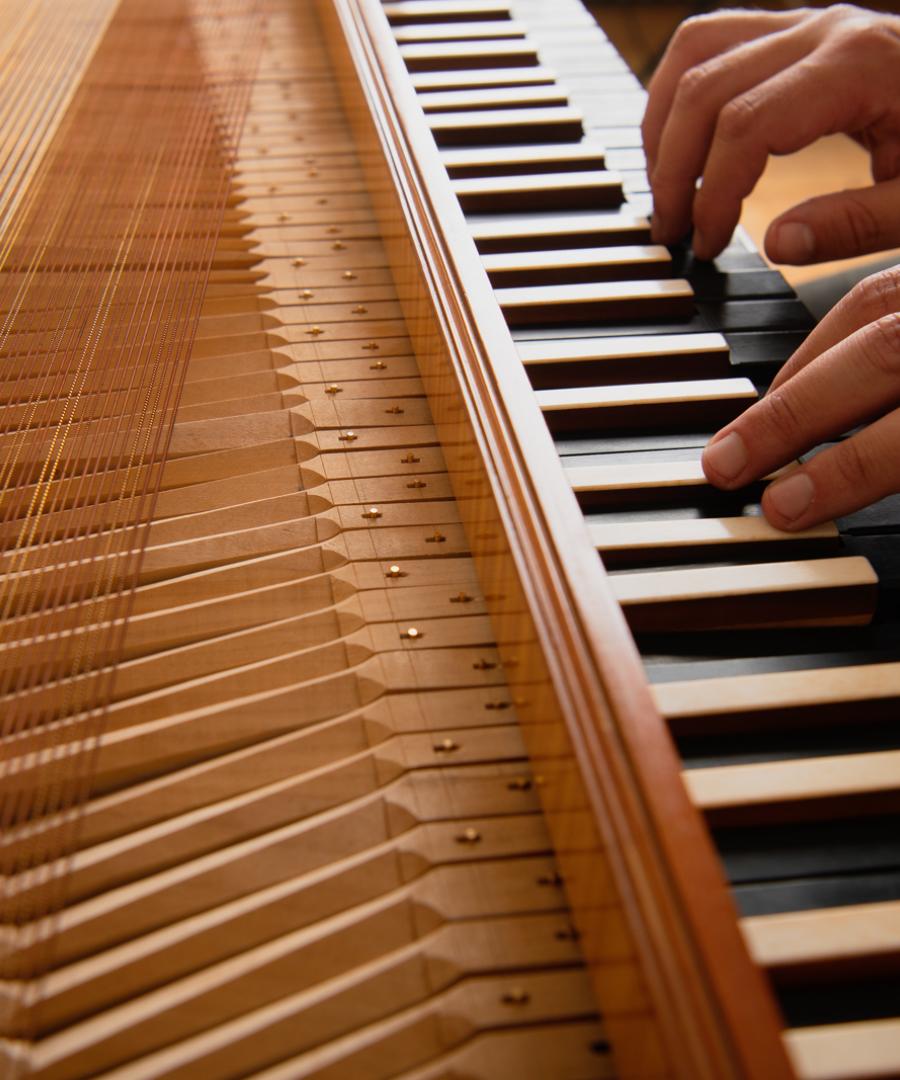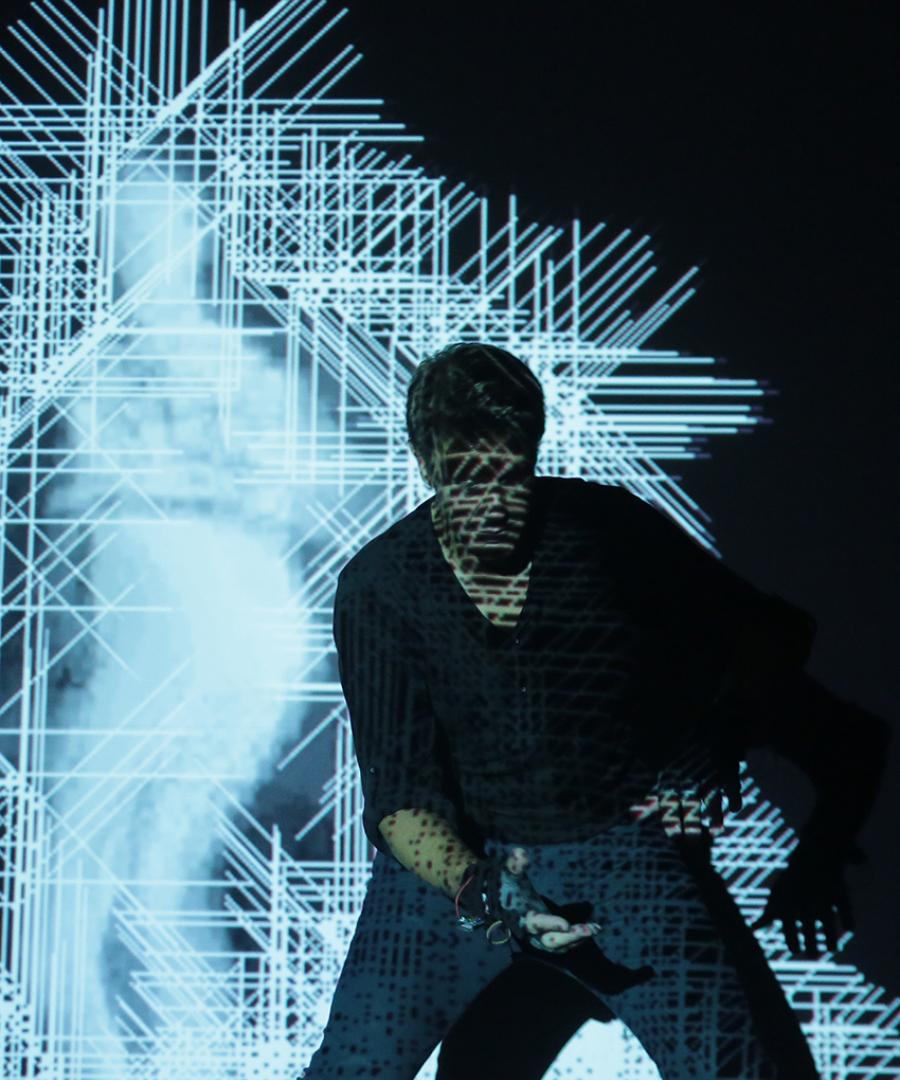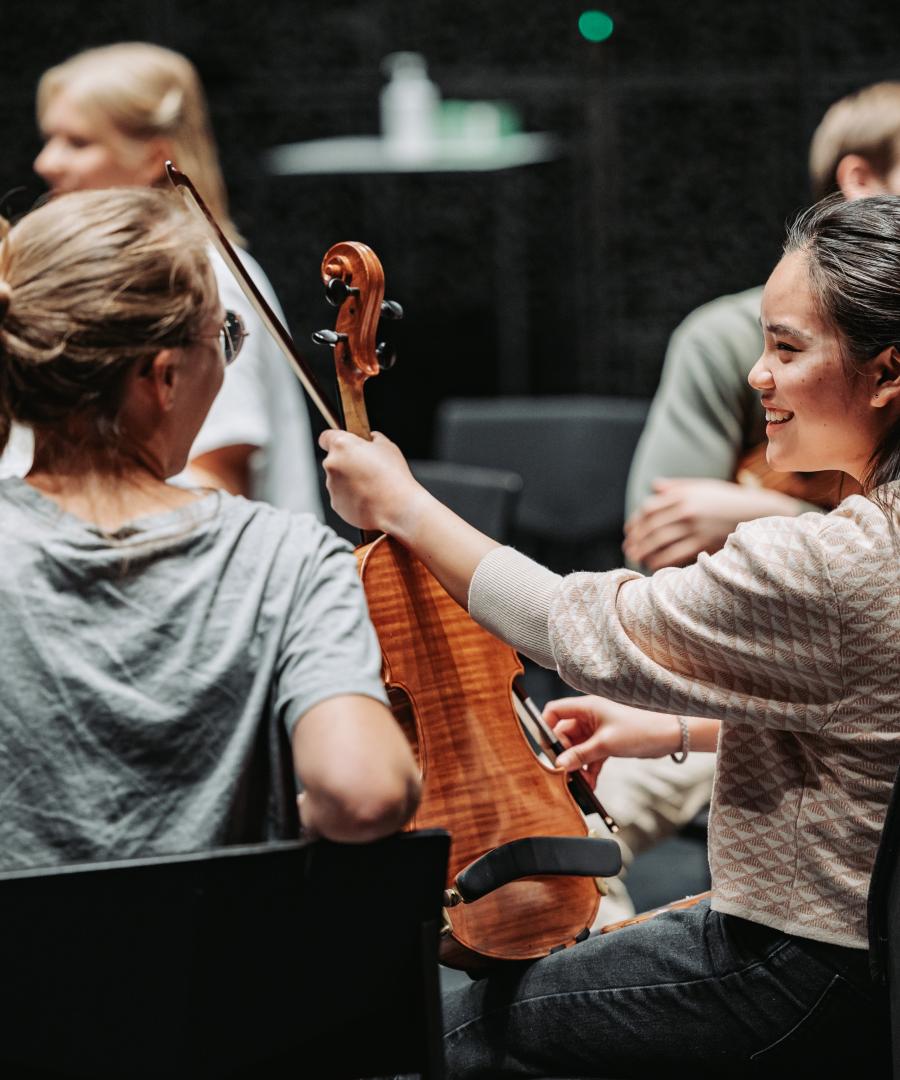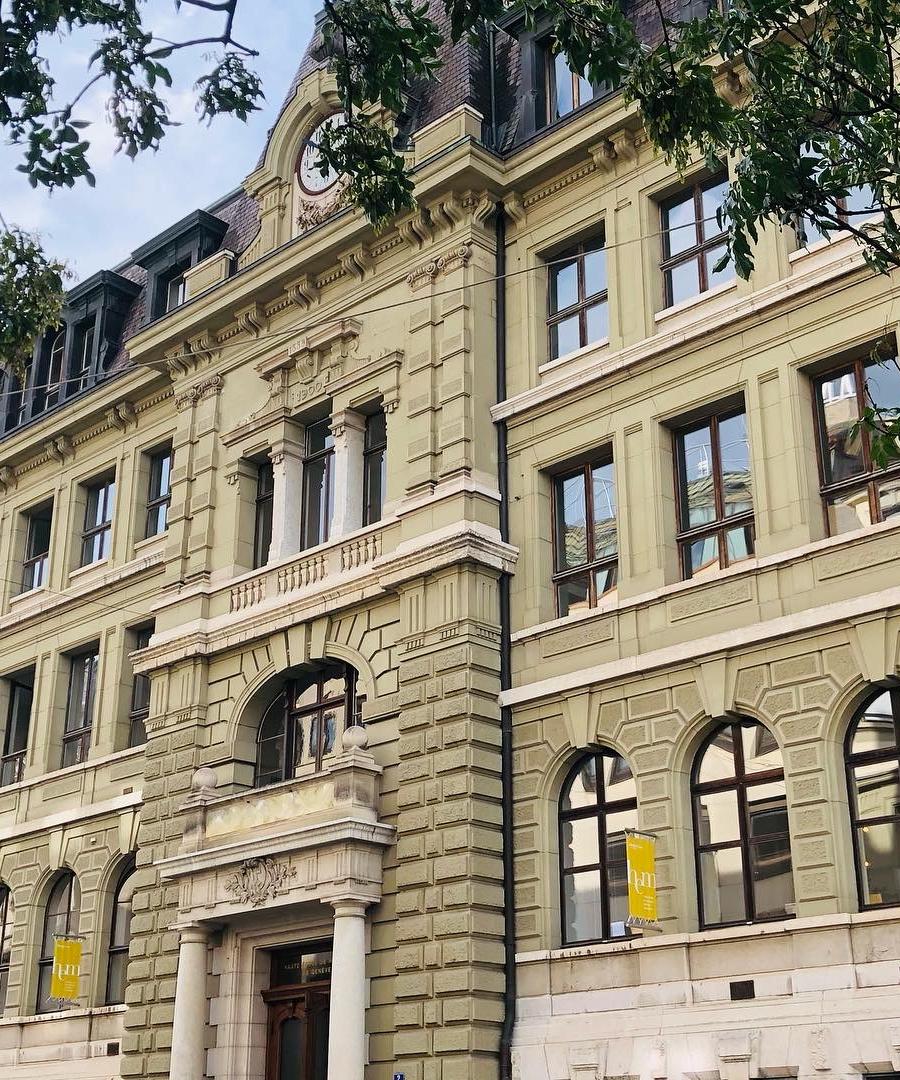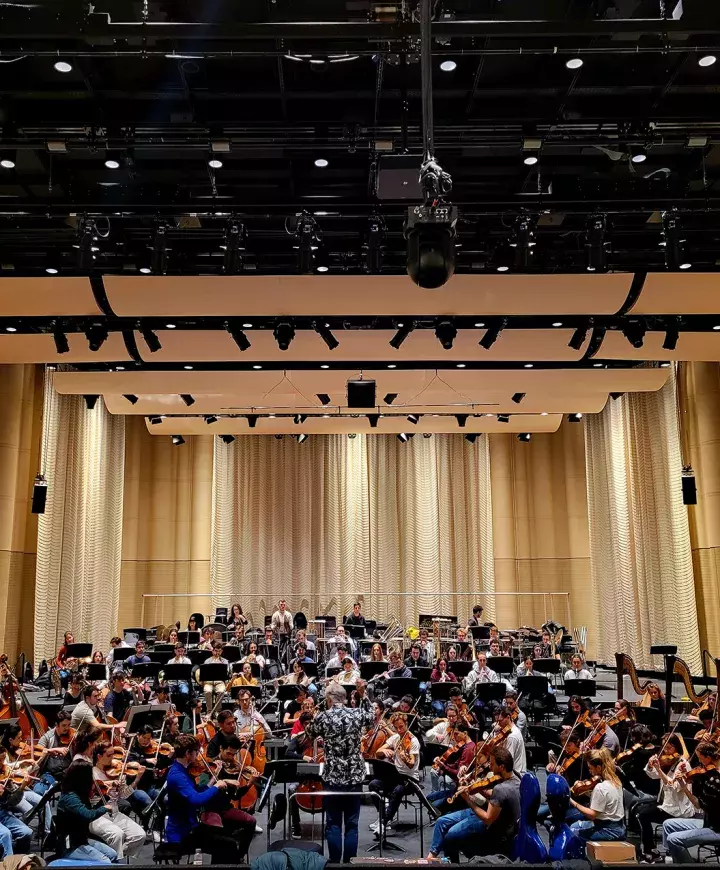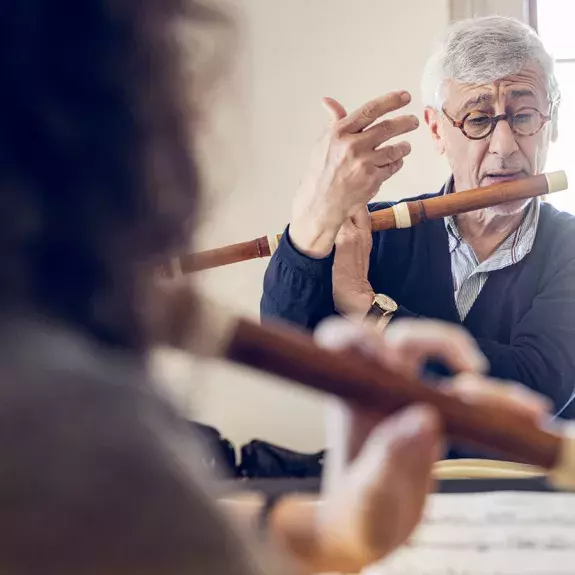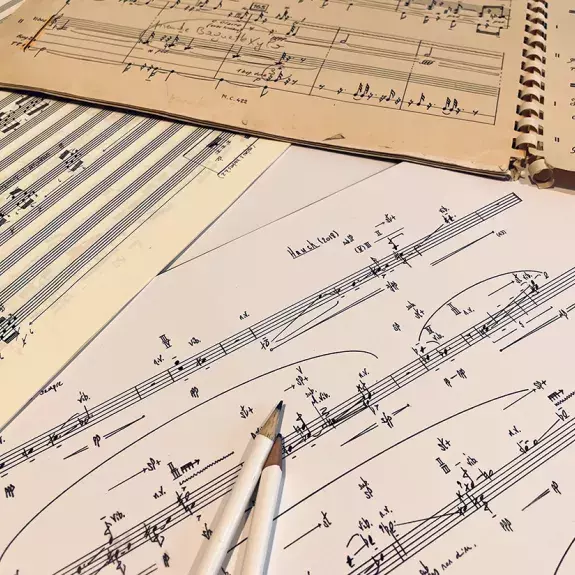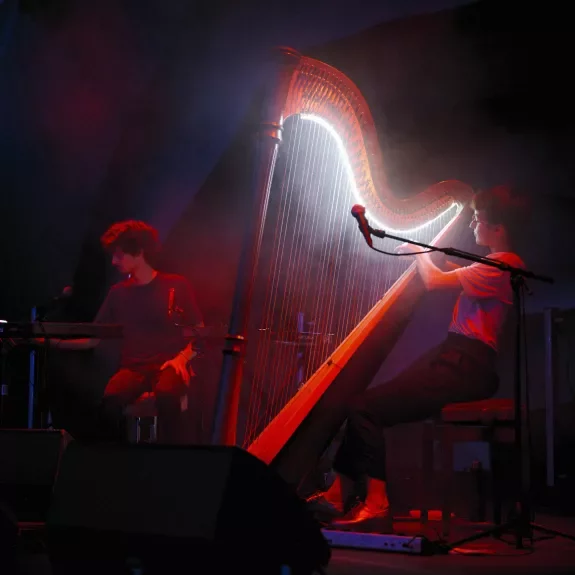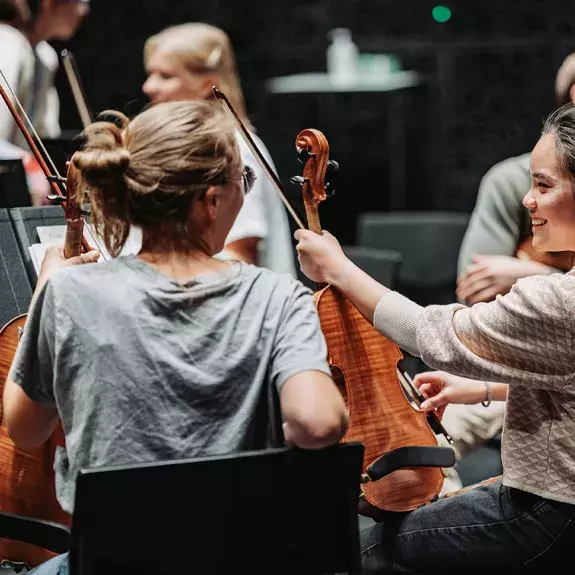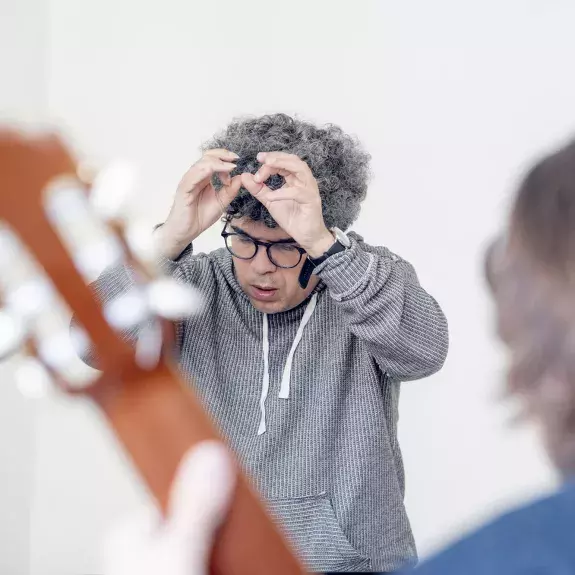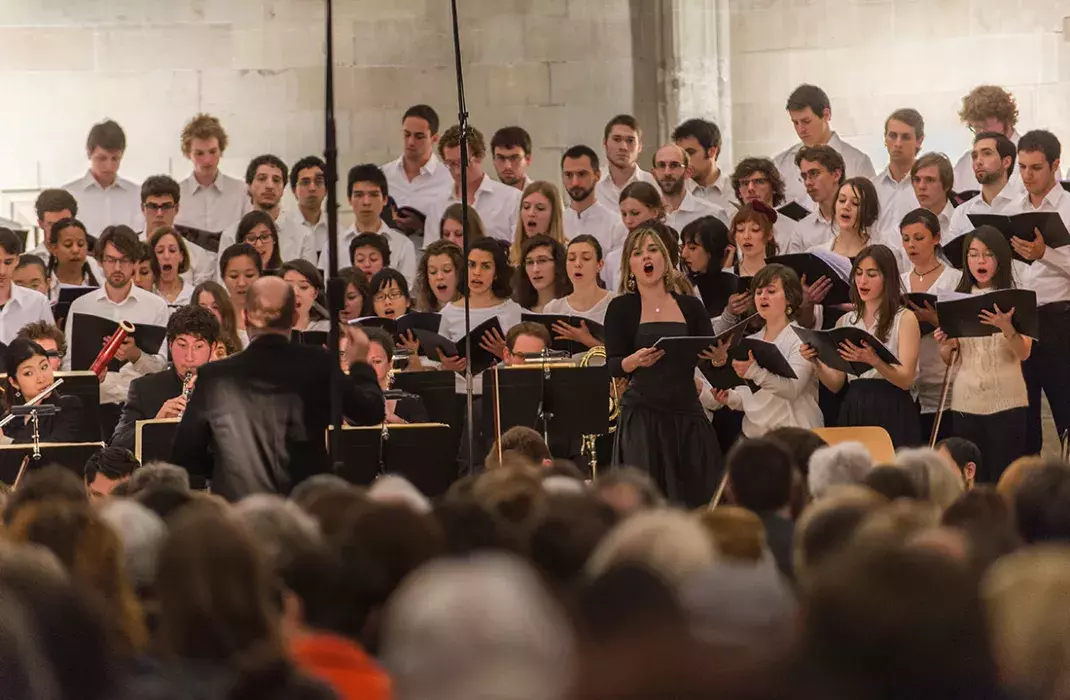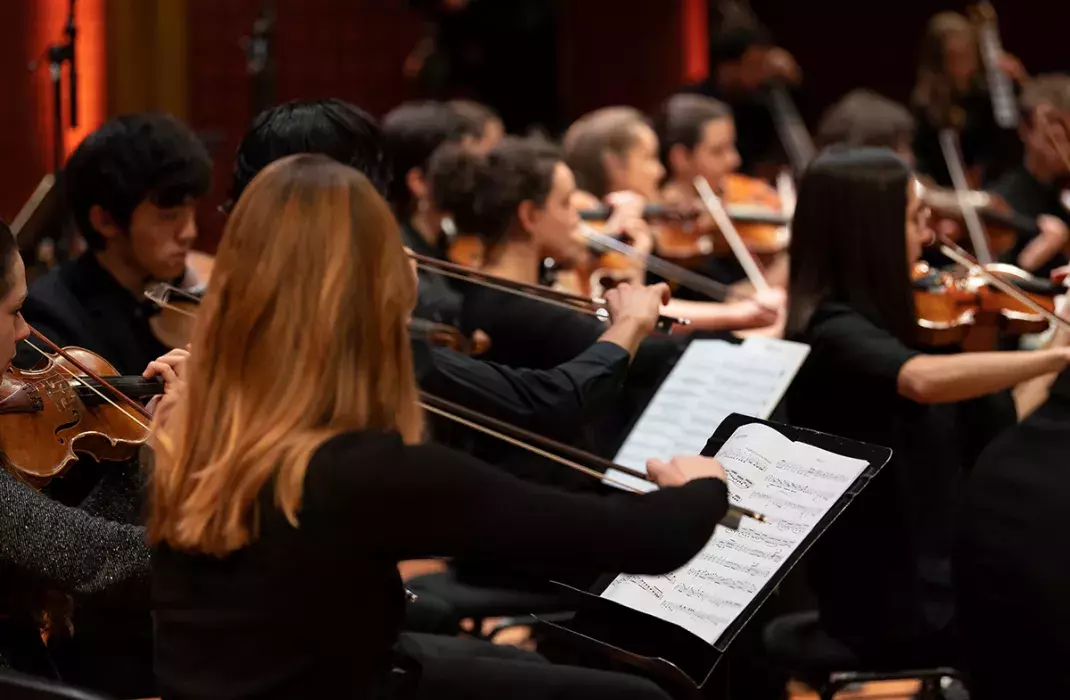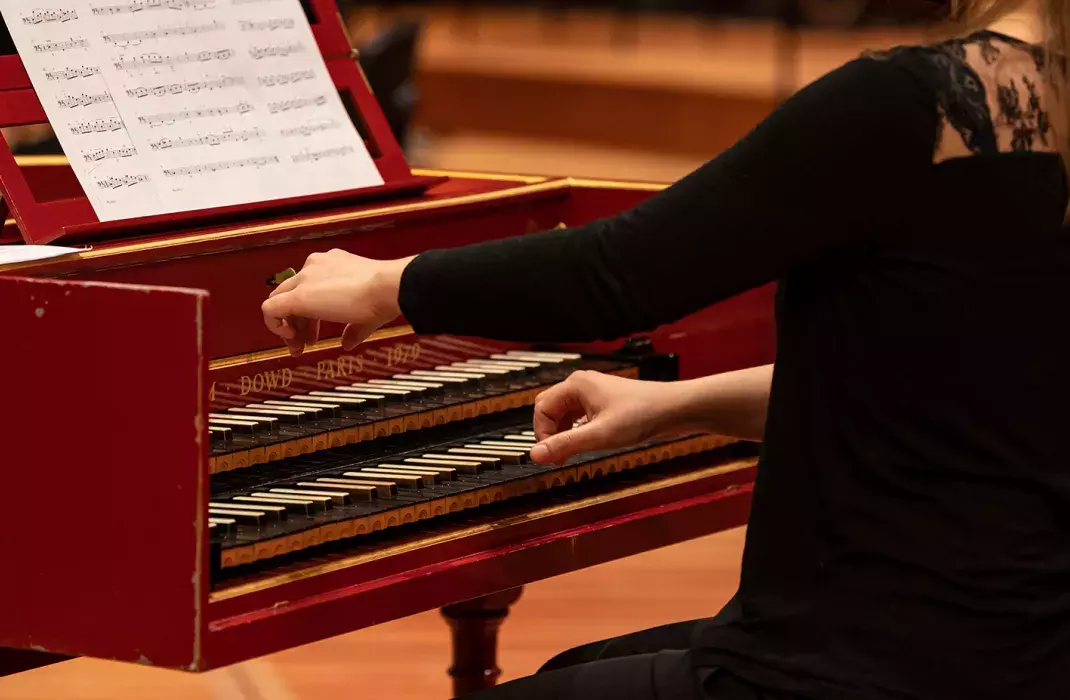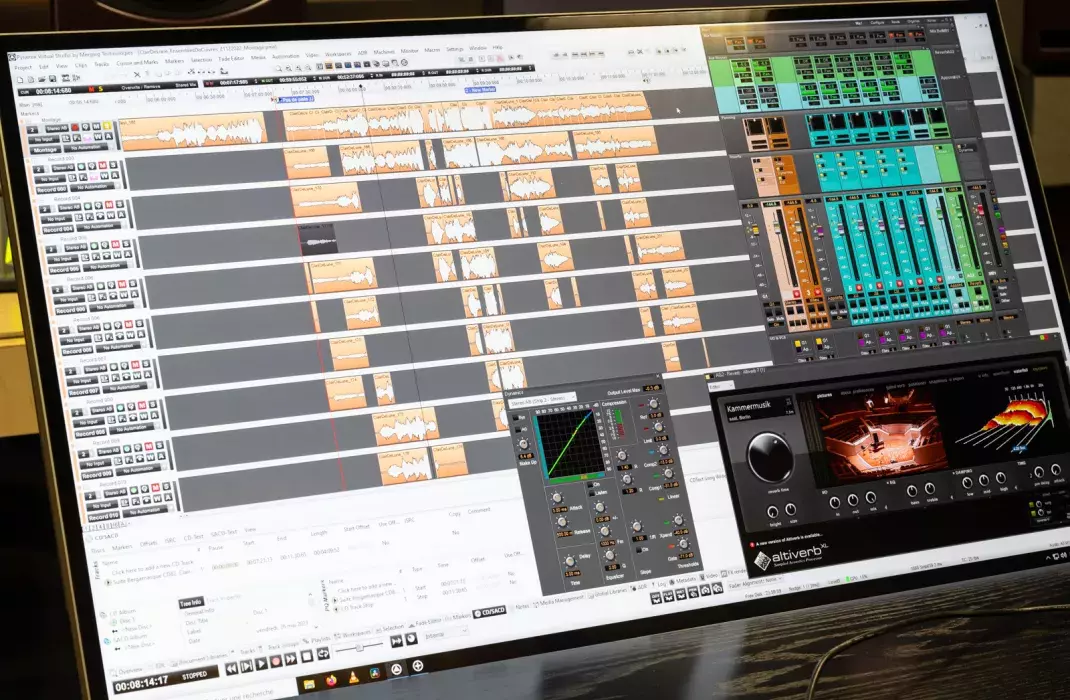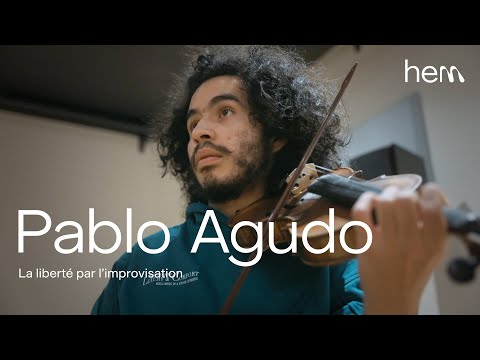- Studies
- Disciplines
- Research
- Events
- The school
Grands ensembles
Many grands ensembles perform under the auspices of the Haute école de musique (HEM). Some are well-established, while others are formed based on specific projects and repertoires, ranging from medieval music to contemporary creations.
All Bachelor’s and Master’s students at the HEM participate in grands ensembles projects. These are conducted either by musicians from the HEM or by prominent musical figures invited for the occasion. These instrumental and/or vocal ensembles also serve as a platform for students specializing in orchestral conducting, choral conducting, and baroque ensemble direction.
Orchestral instruments department
The Orchestre de la HEM
The Orchestre de la Haute école de musique de Genève (HEM) is composed of students from the institution. It benefits from partnerships with renowned professional ensembles in the Lake Geneva region and the collaboration of acclaimed conductors.
As a key cultural player in the region, the Orchestre de la HEM frequently collaborates with the Grand Théâtre de Genève (GTG), the Paléo Festival in Nyon, and the Archipel contemporary music festival. The orchestra academy, organized every two years in partnership with the Zürcher Hochschule der Künste (ZHdK) under the direction of esteemed conductors, is a major event in the school’s calendar. The Orchestre de la HEM also regularly works with the Orchestre de la Suisse Romande (OSR), the Orchestre de Chambre de Genève (OCG), the Ensemble Symphonique Neuchâtelois (ESN), and the Orchestre des Pays de Savoie (OPS).
The promotion of contemporary repertoire, close ties with the HEM’s composition class, and numerous collaborations with the Geneva-based Ensemble Contrechamps enable our students to perform modern music and premiere works by young composers.
The Orchestre de la HEM is conducted by renowned conductors such as Jukka-Pekka Saraste, Leonardo García Alarcón, Pierre-André Valade, Emmanuel Krivine, Pierre Bleuse, Markus Stenz, and Domingo Garcia Hindoyan.
It is also conducted by students from the HEM’s orchestral conducting class (under Professor Laurent Gay) during sessions organized as part of their curriculum.
Since its creation, the Orchestre de la HEM has contributed to several recording projects, some of which have received international critical acclaim.
The Orchestre atelier (for students specializing in orchestral conducting)
Composed of students from the institution, the Orchestre atelier is a flexible ensemble that forms an integral part of the collective practices offered by the HEM.
A true laboratory, it allows students from the orchestral conducting class to experience their discipline in real-life conditions, with an average of one two-day session per month, complementing their table and piano-based courses.
In a spirit of healthy competition, the Orchestre atelier sessions enable musicians to explore central works from the repertoire, ranging from the Classical era to contemporary music, under the guidance of young conductors and the supervision of Laurent Gay, professor of orchestral conducting.
These sessions also provide opportunities, several times a year, for students from the institution to take their first steps as soloists with an orchestra.
This ensemble is also utilized in conducting technique courses for choral conductors, maestro al cembalo students, and composers, allowing them to gain practical experience in orchestral conducting under highly realistic conditions.
The richness and enduring success of the Orchestre atelier lie in its ability to immerse all participants—whether conductors, musicians, or soloists—in the realities of their future professional lives during these sessions, thus enhancing their employability.
The Ensemble HEMisphère
The HEMisphère ensemble was founded in 2021 through the initiative of several HEM professors, all internationally renowned concert performers. Often performing without a conductor, this chamber ensemble is led by a collective of professors who play alongside outstanding HEM students selected through auditions.
Its flexible configuration is tailored to each project. At times a string orchestra, a wind ensemble, a hybrid group for contemporary creations, or a Mannheim formation, this new ensemble bridges individual instruction, chamber music, and in-depth orchestral practice.
As an ambassador of a cosmopolitan and international Geneva, this elite formation fosters interdisciplinary collaborations with other higher education institutions like HEAD or La Manufacture and builds connections with key players in Geneva’s cultural scene, such as the Geneva Competition, the Grand Théâtre, and the Bellerive Festival. It also strengthens ties with HEM alumni and promotes interdepartmental interactions, incorporating diverse disciplines such as composition, multimedia, dance, and even, potentially, theater.
The Ensemble 21
The Ensemble 21 of the HEM is a flexible ensemble dedicated to contemporary repertoire and creation.
Many composers have honored it with their presence and have shared their insights with HEM students, including Henri Dutilleux, Sofia Gubaidulina, Maurice Ohana, Edison Denisov, Klaus Huber, Elliott Carter, Isang Yun, Eric Gaudibert, Yoshihisa Taira, Heinz Holliger, George Benjamin, Helmut Lachenmann, Michael Levinas, Toshio Hosokawa, György Kurtág, Pascal Dusapin, and many others.
Conducted by guest conductors, Ensemble 21 has collaborated with notable institutions such as the Grand Théâtre de Genève, the Contrechamps Ensemble, the Société de Musique Contemporaine de Lausanne, the Amadeus Festival, and the Archipel Festival. It has also been recorded by Radio Suisse Romande during several events.
Ensemble 21 was founded through the initiative of Jean-Jacques Balet, a former professor of chamber music and accompaniment at the HEM, and a passionate advocate for contemporary music. Continuing this project, which was so dear to him, is a way to pay tribute to his legacy.
Red Flag Ensemble
The Red Flag Ensemble is an ensemble composed of students from the HEM. Under the guidance of our professor Hélène Escriva, the Red Flag Ensemble designs and implements experimental artistic projects with unlimited aesthetics by collaborating with artists from diverse backgrounds. Conceived as a living laboratory, it cultivates creativity, interdisciplinary encounters, non-conformism and conviviality.
HEM Big Band
Under the direction of our saxophone professor Joshua Hyde, the HEM Big Band brings together HEM students to perform a repertoire of jazz standards in a large ensemble, in the grand tradition of the legendary bands of Duke Ellington, Count Basie and Benny Goodman. Since its creation in 2023, the HEM Big Band has been regularly invited to perform at major festive events. Notably, it opened the 2024 Geneva Music Festival on the forecourt of the Grand Théâtre and provided the entertainment for the closing dance party celebrating the HEM's 15th anniversary at the BFM in Geneva in February 2025.
Vocal department
The Chœur de chambre de la HEM
Historically, the choral tradition has always held a special place within the HEM and in Switzerland more broadly. The HEM Chamber Choir is one of the school’s permanent ensembles. It provides vocal department students with the opportunity to explore a demanding choral repertoire that requires advanced vocal technique and exceptional quality.
This prestigious choir performs both a cappella and with an orchestra, collaborating with esteemed partners such as the OSR. The HEM Chamber Choir’s repertoire spans from Renaissance music to contemporary creations, including the premiere of several works by modern composers.
The Grand chœur de la HEM
The HEM Choral Workshop is one of the school’s permanent ensembles, designed to provide ensemble practice for around a hundred students from various disciplines. This includes primarily pianists, organists, and guitarists, as well as students from theoretical branches, the Music and Movement program, and a few vocalists.
As part of the "artistic community" formed by all contributors to the school’s musical life, the Choral Workshop undertakes independent artistic projects and also collaborates on major initiatives within the HEM and with external partners.
The Chœurs ateliers (for students specializing in choral conducting)
The chœurs ateliers serve as practical ensembles for students in the choral conducting class. They are composed of vocal students, along with external singers who strengthen the ranks. Each session focuses on a new repertoire, ranging from Renaissance chants to contemporary music.
The workshop choirs participate in various activities within the vocal department, such as regular choral conducting classes, choral conducting masterclasses, conducting students’ exams, choral arrangement classes, and more. These choirs provide invaluable opportunities for conducting students to work with a professional-level choir, as well as for singers to refine their choral skills and explore central works of the repertoire.
Early music department
The Early Music Department Orchestra
This is a grand ensemble with a flexible structure that invites various renowned conductors to explore a wide orchestral repertoire ranging from the 17th to the 19th century.
The Baroque Lab
Formerly known as "Les Madrigalistes," the Baroque Lab is a group course led by Leonardo García Alarcón, welcoming vocal students, continuo players, and melodic historical instrument performers. Two auditions are held each year.
The Grand ensemble Renaissance
This ensemble explores all vocal forms of the 16th and 17th centuries, including French chansons, madrigals, and Flemish, Italian, or German motets. In-depth work on polyphony, intonation, text, and reading from facsimiles forms the foundation of this ensemble, whose mission is to uncover and share lesser-known repertoires.
The Ensemble vocal Renaissance
This ensemble aims to explore all vocal forms of the 16th and 17th centuries, such as French chansons, madrigals, and Flemish, Italian, or German motets. Thorough work on polyphony, intonation, text, and reading from facsimiles forms the foundation of this ensemble, which is dedicated to uncovering and showcasing lesser-known repertoires.
The Ensemble médiéval
This ensemble is composed of singers and instrumentalists who wish to explore the medieval repertoire, along with its specific notations and aesthetics.
The Ensemble grégorien
In this ensemble, students are guided in the interpretation of Gregorian chant by Professor Luca Ricossa, a renowned specialist in this repertoire.
The Consorts de la HEM (flûte à bec, viole de gambe, saqueboute, cornet, douçaine)
At the DMA, instrument practice within the main discipline course occurs not only individually but also within consorts (either full or broken). This applies to instruments such as the recorder, viola da gamba, sackbut, cornett, or dulcian, depending on the preferences and projects of the professors leading these consorts.
